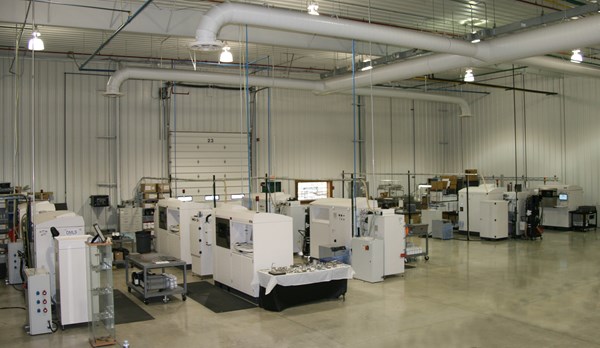Additive Manufacturing on the Shop Floor
C&A recently added two new machines from EOS to the company’s stable of additive manufacturing machines, bringing the total to eight.

Additive manufacturing in production at C&A Tool.
Founded in 1969 as a tool and die maker, C&A Tool (Churubusco, Indiana) has grown to 700,000 square feet of manufacturing space and more than 560 employees. This growth is a reflection of owner Richard Conrow’s, continued investment in technology to serve the company’s varied customer base in medical, aerospace, industrial and fuels systems markets.
Eight years ago, Mr. Conrow invested in additive technology. He was an early adopter, but could see the technology’s potential as a manufacturing game changer.
C&A recently added two new machines from EOS to the company’s stable of additive manufacturing machines, bringing the total to eight. These are not lab machines—they are production machines capable of manufacturing parts in titanium, aluminum, stainless, cobalt, chrome and Inconel.
Additive manufacturing (AM)—also known as 3D printing, freeform fabrication and laser sintering—is an emerging technology defined by ASTM Committee F42 as the process of joining materials to make objects from 3D model data, usually layer upon layer, as opposed to subtractive manufacturing methodologies. C&A continues to build on its experience using and refining the process to produce parts. They are way beyond potential.
According to Rich Stephenson, additive development representative, “Additive technology will enable the customer to have freedom of design, because it is design-driven manufacturing instead of manufacturing-driven design. This technology enables the development of parts to be more durable by eliminating welds used in traditional methods. The parts can be more cost-effective and can be grown to eliminate assembly operations, resulting in time savings. It’s also a greener alternative to traditional manufacturing, with little to none material waste. And this technology can also help eliminate the need for some inventory by being able to manufacture parts in small lots, even as small as one (1) in a short amount of time.”
There is much interest throughout the precision machined parts industry about AM. C&A is at the forefront of its successful application. Click here to learn more about EOS AM equipment eos.info, and click here to learn more about C&A Tool.



